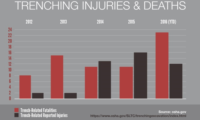 The death of a railroad foreman who was struck by a train last month has led to urgent recommendations from the National Transportation Safety Board (NTSB) for ways to improve safety for track maintenance crews to provide signal protection.
The death of a railroad foreman who was struck by a train last month has led to urgent recommendations from the National Transportation Safety Board (NTSB) for ways to improve safety for track maintenance crews to provide signal protection.
A student controller reopened track
In the incident on May 28th, a track foreman for Metro-North Railroad was struck and killed by a Metro-North passenger train traveling at 70 mph in West Haven, Conn. The foreman had requested the section of track be taken out of service for maintenance. Two Metro-North rail traffic controllers, one of whom was a student controller, placed the section out of service. But the student controller reopened the track a little more than an hour later without the appproval of the qualified controller or the foreman.
Prior to this collision, on May 4, 2013, another Metro-North rail traffic controller mistakenly placed out-of-service track back in service. Two days later, Metro-North instituted additional operations control procedures, but these procedures did not prevent the May 28 fatal collision.
Simple, feasible and available
“The procedures currently in place are ineffective.” said NTSB Chairman Deborah A.P. Hersman. “Metro-North can take immediate action to ensure the safety of work crews on their tracks. Shunting tracks is simple, feasible and readily available.”
The NTSB is urgently recommending that Metro-North require redundant signal protection, such as shunting, for maintenance-of-way work crews who depend on the train dispatcher to control access to occupied sections of track. A shunt is a device that crews can attach to the rails in a work zone that alerts the controller and gives approaching trains a stop signal.
A link to the full recommendation and the letter to MTA Metro-North Railroad can be found at www.ntsb.gov/doclib/recletters/2013/R-13-17.pdf
Other accidents
The NTSB has investigated other collisions involving train movements on tracks occupied by work crews. On January 9, 2007, a Massachusetts Bay Transportation Authority passenger train struck a track maintenance vehicle that was on the track near Woburn, Mass. Of the six maintenance-of-way employees working on or near the track maintenance vehicle, two were killed, and two were seriously injured. The NTSB determined that the probable cause of that collision was (1) the failure of the train dispatcher to maintain blocking that provided signal protection for the track segment occupied by the maintenance-of-way work crew, and (2) the failure of the work crew to apply a shunting device that would have provided redundant signal protection for their track segment. Contributing to the accident was Massachusetts Bay Commuter Railroad’s failure to ensure that maintenance-of-way work crews applied shunting devices, as required by its own rules.
The Woburn report and recommendations can be found at www.ntsb.gov/news/events/2008/Woburn_ma/index.html
The NTSB said that a redundant means of protecting railroad maintenance-of-way workers from train movements is critically needed and is concerned that these preventable events continue to occur. The Board sent a letter to the Federal Railroad Administration reiterating an earlier safety recommendation made along those same lines in the Woburn collision.
The West Haven investigation is still underway. A probable cause has yet to be determined and additional safety recommendations may be issued at the completion of the investigation.
The NTSB is also continuing to investigate the May 17, 2013 derailment and collision of two Metro-North trains in Bridgeport, Conn.



